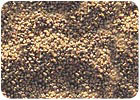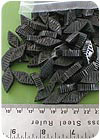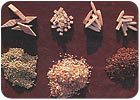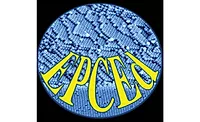Wet vs. Dry Finishing
Within the last five years, suppliers have found a way to make sawdust-sized, random dry organic particulate materials into shapes to give the media more bulk and mass, similar to wood shapes. The additional weight of the new dry organic media makes it basically perform the same as ceramic or plastic, except there is no need for water or chemicals.

In the past, when surface deburring or polishing, one normally thought in terms of wet processing using only tumblers. Mechanical barrel systems have been around since ancient times and were used with hard, nearly non-abrasive materials and copious amounts of water to achieve relatively clean, bright and smooth finishes on metal parts after an extended period of tumbling. The process was similar to the natural action of a river smoothing and polishing rocks over a long period of time.
Over the years, numerous improvements have been made in mass finishing equipment to speed up the processing and finishing of machined parts. However, while the equipment has advanced, the selection of abrasives - known as “media” - has changed little until recently. The basic premise of mass finishing media has remained: The greater the particle size and weight, and the harder the abrasive, the better and faster it is for deburring or material removal.
With today’s alloys and the speed of modern cutting machinery, water and rocks are no longer good enough. Many manufacturing facilities now use special chemical cutting fluids, which have improved all types of machining operations. Additionally, media now appear in uniform geometric sizes and shapes, composed of different abrasive grits with sophisticated bonding agents. These advanced abrasive and non-abrasive materials provide a significant improvement over nature in their material removal capabilities. They also behave in a predictable manner, making mass finishing systems a reliable secondary operation.
Unfortunately, the use of chemicals in both cutting and finishing operations has created some new challenges, leaving many finishing professionals looking for an alternative to wet finishing systems.

All of these unknowns can negatively affect the finishing operation. Additionally, if the chemical used in the deburring operation doesn’t clean the material properly, the surface finishing process will take more time and still may not achieve the desired final appearance.
Safety and environmental factors also must be considered. Even if all of the chemicals used in both the machining and finishing operations are carefully controlled, the wastewater must still be disposed of properly. Most chemical additives used today are water-based and biodegradable, but certain metals or material contaminates can go into solution and not readily settle out. For example, in the mass finishing of stainless steel parts, there is a concern by the Environmental Protection Agency (EPA) that the chromium in this material - a carcinogenic agent - can go into solution. If that happens, even expensive filtration systems may not remove enough of these molecules to make the wastewater “safe.”
The bottom line is that there are a lot of hidden costs and operations associated with wet parts processing or surface finishing. Where does the cost of chemicals and/or their treatment come in? What equipment or accessory supplies are needed in the treatment of these chemicals and byproducts? Is there a need for protective clothing or safety equipment? What are the costs of all the supplies and indirect labor needed to sustain these operations? Additionally, what about the costs to dry or treat the parts against oxidation? All of these factors must be considered in evaluating the overall cost of the operation.

The main reason for the time difference between wet and dry processes is the different types of abrasive media that are used. The heavier the abrasive, the greater the pressure on the parts and the shorter the processing time. Wet processing uses ceramic ceramic deburring media, which typically weighs about 80 to 110 lb/ft3, or plastic media, which weighs around 50 to 85 lb/ft3. Conversely, the dry organic materials used in dry deburring systems typically weigh between 20 to 35 lb/ft3. In their granular sawdust form using the same equipment, the dry materials generally require at least two to five times longer to achieve deburring compared to ceramic or plastic materials.
Another reason for the difference in processing times is that dry organic materials have previously only been available as small, granular, loose particles. These small, friable particles exert less energy, pressure, and mass on parts than that of abrasive preform media shapes. Processing times for loose, dry organic materials can range anywhere from two to five days in a barrel tumbler, to 24 hours in a vibratory machine system and one to four hours in a high-energy centrifugal mass finishing machine.
To speed up cycle times using dry organic materials, the common practice has been to add wood pieces or shapes to the small, granular organic materials. In fact the recommended blend is five parts wood shapes to one part sawdust-sized particles. Porcelain or non-abrasive ceramic and, to a lesser extent, plastic materials can also be added to loose particles for greater weight and/or processing than wood. The greater the amount and size of preform shapes, the faster the material removal or finishing process. However, the more loose particles, the finer the surface finish.
Inorganic materials alone can be used dry to deburr parts, but these materials leave the parts with an extremely rough surface finish, and the media itself has a very short life, probably equal to that of abrasive blast systems. Mixing inorganic materials with loose, dry organic materials, can greatly improve the surface finish and life of the media. Typically, pumice is added to the dry organic materials, along with a sticky binder to hold the two together. Other inorganic materials such as aluminum oxide or zirconium can also be used. Polishing additives or rouge can also be added to create a blend for better-looking parts. Pretreated dry organic materials are readily available.
Recently, there have been some new developments in dry organic media. Within the last five years, suppliers have found a way to make sawdust-sized, random dry organic particulate materials into shapes to give the media more bulk and mass, similar to wood shapes. When inorganic materials are blended with organic materials in a patented resin bond process to create a preform shape, their weight increases to about 65 to 85 lb/ft3. The additional weight makes the dry organic media basically perform the same as ceramic or plastic, except there is no need for water or chemicals. Additionally, the flexibility of the organic materials expands the life of the media itself by as much as five to 20 times that of standard ceramic media in a wet finishing process.

Another drawback to the new organic media shapes is the cost - around $12/lb currently. However, because the wear rate of the new media is five to 20 times that of ceramic or plastic, less replacement media is required, which also provides a substantial savings in freight costs. Additionally, the overall benefits of using a dry system might easily outweigh the higher media price. For example, dry processes don’t require water, wastewater treatment or chemicals, and costs for maintaining the processing equipment and general labor are lower. Without water, there are no immediate rust problems and no sticking together of flat or lightweight parts. Parts emerge from the finishing process clean, dry and ready for the next operation. To some extent, the dry process also reduces surface work hardening.
One other drawback must also be considered. Because organic material is lightweight and friable, dry processing creates dust and airborne particles. A closed loop processing chamber is suggested, and this does add some extra expense to the mass finishing system. While barrel machines are completely enclosed, vibratory systems will require some form of cover, as will disc machines or airflow collection systems.

In the past, when surface deburring or polishing, one normally thought in terms of wet processing using only tumblers. Mechanical barrel systems have been around since ancient times and were used with hard, nearly non-abrasive materials and copious amounts of water to achieve relatively clean, bright and smooth finishes on metal parts after an extended period of tumbling. The process was similar to the natural action of a river smoothing and polishing rocks over a long period of time.
Over the years, numerous improvements have been made in mass finishing equipment to speed up the processing and finishing of machined parts. However, while the equipment has advanced, the selection of abrasives - known as “media” - has changed little until recently. The basic premise of mass finishing media has remained: The greater the particle size and weight, and the harder the abrasive, the better and faster it is for deburring or material removal.
With today’s alloys and the speed of modern cutting machinery, water and rocks are no longer good enough. Many manufacturing facilities now use special chemical cutting fluids, which have improved all types of machining operations. Additionally, media now appear in uniform geometric sizes and shapes, composed of different abrasive grits with sophisticated bonding agents. These advanced abrasive and non-abrasive materials provide a significant improvement over nature in their material removal capabilities. They also behave in a predictable manner, making mass finishing systems a reliable secondary operation.
Unfortunately, the use of chemicals in both cutting and finishing operations has created some new challenges, leaving many finishing professionals looking for an alternative to wet finishing systems.

Wet processing often uses plastic media, which weighs around 50 to 85 lb/ft3. Photo courtesy of Dave Davidson, Society of Manufacturing Engineers (SME) Deburring/Surface Finishing Tech Group.
Wet Processing Drawbacks
Chemicals are formulated to perform specific tasks, such as extracting heat or removing material chips, oils or other debris. As a result, they react with both solids and liquids. They also leave residues on parts when they dry. Because mass finishing is a secondary operation that is normally performed in an area separate from the primary cutting operation, the composition of the cutting fluids may be unknown. If multiple machining operations take place prior to the finishing operation, different chemical fluids can combine or react with one another to create yet another unknown chemical compound.All of these unknowns can negatively affect the finishing operation. Additionally, if the chemical used in the deburring operation doesn’t clean the material properly, the surface finishing process will take more time and still may not achieve the desired final appearance.
Safety and environmental factors also must be considered. Even if all of the chemicals used in both the machining and finishing operations are carefully controlled, the wastewater must still be disposed of properly. Most chemical additives used today are water-based and biodegradable, but certain metals or material contaminates can go into solution and not readily settle out. For example, in the mass finishing of stainless steel parts, there is a concern by the Environmental Protection Agency (EPA) that the chromium in this material - a carcinogenic agent - can go into solution. If that happens, even expensive filtration systems may not remove enough of these molecules to make the wastewater “safe.”
The bottom line is that there are a lot of hidden costs and operations associated with wet parts processing or surface finishing. Where does the cost of chemicals and/or their treatment come in? What equipment or accessory supplies are needed in the treatment of these chemicals and byproducts? Is there a need for protective clothing or safety equipment? What are the costs of all the supplies and indirect labor needed to sustain these operations? Additionally, what about the costs to dry or treat the parts against oxidation? All of these factors must be considered in evaluating the overall cost of the operation.

Dry processing uses dry organic materials, often in conjunction with wood pieces or shapes to speed up cycle times. Photo courtesy of Dave Davidson, SME.
A Dry Alternative
Dry processing media has been used for some time in the mass finishing industry to dry or polish parts. Adding inorganic pumice to organic materials creates an effective deburring media. However, the dry deburring process is more time consuming than wet methods and is not considered a serious option for large-volume production.The main reason for the time difference between wet and dry processes is the different types of abrasive media that are used. The heavier the abrasive, the greater the pressure on the parts and the shorter the processing time. Wet processing uses ceramic ceramic deburring media, which typically weighs about 80 to 110 lb/ft3, or plastic media, which weighs around 50 to 85 lb/ft3. Conversely, the dry organic materials used in dry deburring systems typically weigh between 20 to 35 lb/ft3. In their granular sawdust form using the same equipment, the dry materials generally require at least two to five times longer to achieve deburring compared to ceramic or plastic materials.
Another reason for the difference in processing times is that dry organic materials have previously only been available as small, granular, loose particles. These small, friable particles exert less energy, pressure, and mass on parts than that of abrasive preform media shapes. Processing times for loose, dry organic materials can range anywhere from two to five days in a barrel tumbler, to 24 hours in a vibratory machine system and one to four hours in a high-energy centrifugal mass finishing machine.
To speed up cycle times using dry organic materials, the common practice has been to add wood pieces or shapes to the small, granular organic materials. In fact the recommended blend is five parts wood shapes to one part sawdust-sized particles. Porcelain or non-abrasive ceramic and, to a lesser extent, plastic materials can also be added to loose particles for greater weight and/or processing than wood. The greater the amount and size of preform shapes, the faster the material removal or finishing process. However, the more loose particles, the finer the surface finish.
Inorganic materials alone can be used dry to deburr parts, but these materials leave the parts with an extremely rough surface finish, and the media itself has a very short life, probably equal to that of abrasive blast systems. Mixing inorganic materials with loose, dry organic materials, can greatly improve the surface finish and life of the media. Typically, pumice is added to the dry organic materials, along with a sticky binder to hold the two together. Other inorganic materials such as aluminum oxide or zirconium can also be used. Polishing additives or rouge can also be added to create a blend for better-looking parts. Pretreated dry organic materials are readily available.
Recently, there have been some new developments in dry organic media. Within the last five years, suppliers have found a way to make sawdust-sized, random dry organic particulate materials into shapes to give the media more bulk and mass, similar to wood shapes. When inorganic materials are blended with organic materials in a patented resin bond process to create a preform shape, their weight increases to about 65 to 85 lb/ft3. The additional weight makes the dry organic media basically perform the same as ceramic or plastic, except there is no need for water or chemicals. Additionally, the flexibility of the organic materials expands the life of the media itself by as much as five to 20 times that of standard ceramic media in a wet finishing process.

Within the last five years, suppliers have found a way to make sawdust-sized random dry organic particulate materials into shapes to give the media more bulk and mass, similar to wood shapes. The added weight of these shaped organic media puts them on par with ceramic materials in terms of performance. Photo courtesy of Mark Cantwell, Finishing Associates Inc.
Considerations
The new shaped organic media is an excellent alternative deburring process; however, because of the inorganic additives, it cannot match the smooth, polished finishes of the loose pretreated organic materials. Achieving nearly buffed, smooth, polished surface finishes still requires the use of organic materials and additives, preferably in a closed-loop system to generate extra heat.Another drawback to the new organic media shapes is the cost - around $12/lb currently. However, because the wear rate of the new media is five to 20 times that of ceramic or plastic, less replacement media is required, which also provides a substantial savings in freight costs. Additionally, the overall benefits of using a dry system might easily outweigh the higher media price. For example, dry processes don’t require water, wastewater treatment or chemicals, and costs for maintaining the processing equipment and general labor are lower. Without water, there are no immediate rust problems and no sticking together of flat or lightweight parts. Parts emerge from the finishing process clean, dry and ready for the next operation. To some extent, the dry process also reduces surface work hardening.
One other drawback must also be considered. Because organic material is lightweight and friable, dry processing creates dust and airborne particles. A closed loop processing chamber is suggested, and this does add some extra expense to the mass finishing system. While barrel machines are completely enclosed, vibratory systems will require some form of cover, as will disc machines or airflow collection systems.
Weighing the Options
Both wet and dry systems have their advantages and disadvantages. However, dry systems, by their very nature, are cleaner and more easily controlled than wet systems. As more rules and regulations are imposed on the use of chemicals, and as more advances are made in dry processing media, the use of dry mass finishing systems will likely become increasingly popular in the future.Links
Looking for a reprint of this article?
From high-res PDFs to custom plaques, order your copy today!






